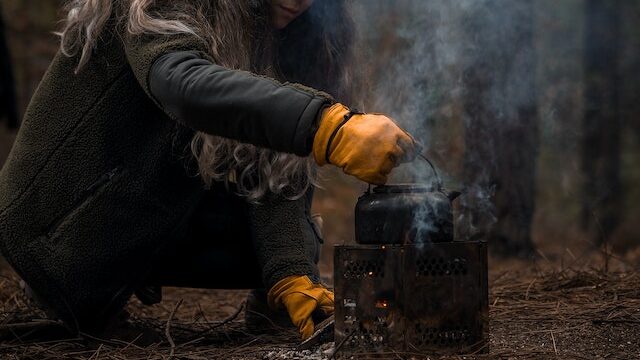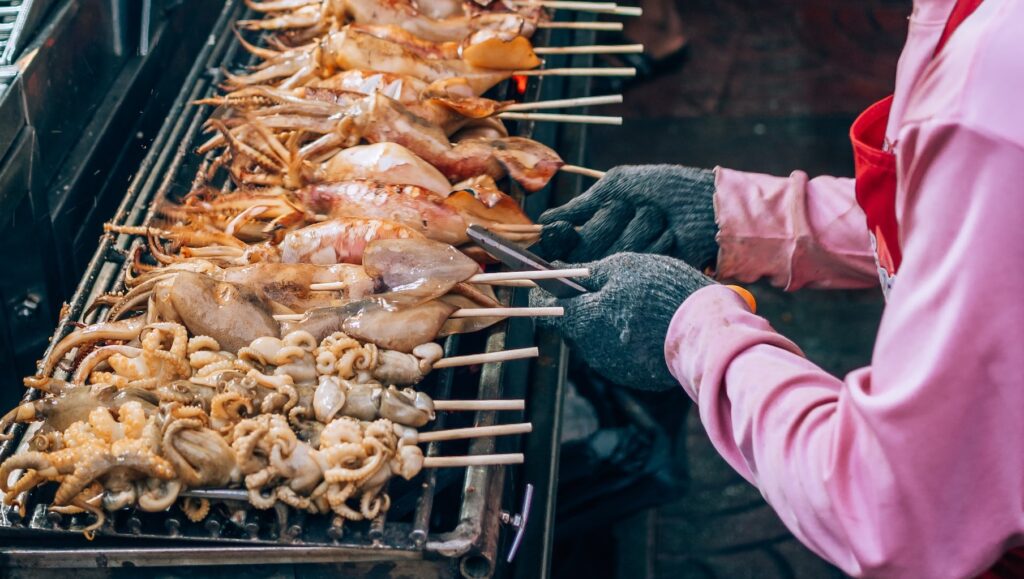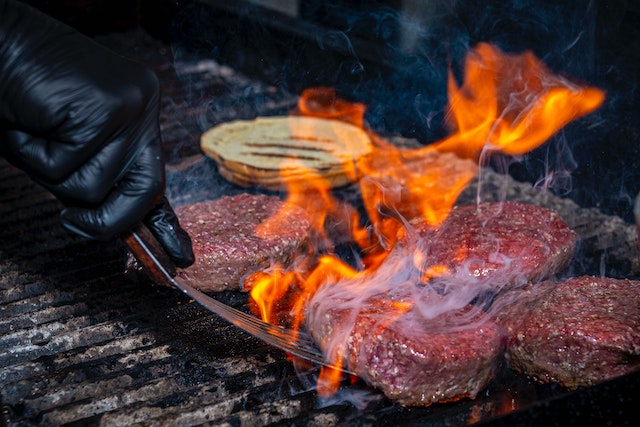Cooking Gloves: Finding the Perfect Pair for Every Dish
Cooking gloves might seem like mere pieces of fabric or other materials, designed solely to act as a barrier between your skin and the hot utensils or food. But these gloves are carefully designed, with materials chosen specifically for heat resistance, grip, and durability.
Why Every Outdoor Cook Needs Them
Outdoor cooking, while fun, has the unpredictable nature of open flames, the variability of outdoor temperatures, and the variety of tasks from handling hot utensils to direct food manipulation, all make the case for the need for protection.
Safety First
The primary role of cooking gloves is to protect. When you’re flipping burgers, roasting marshmallows over an open flame, or moving around scorching pans, there’s always that risk of accidental burns. And let’s not forget those sneaky ember sparks! Cooking gloves, especially those designed for outdoor use, are made to withstand high temperatures, ensuring your hands remain unscathed. It’s a safety net, allowing you to enjoy the cooking process without the constant worry of potential mishaps.
Versatility in Cooking
Have you ever tried moving a skewer of sizzling kebabs with just tongs? Or adjusting logs in a campfire for an even flame? Sometimes, our hands are our best tools. Cooking gloves provide protection without compromising on the tactile connection between the cook and the task at hand. Whether it’s adjusting hot grills, repositioning food for even cooking, or even pulling apart that perfectly smoked pork, gloves give you the freedom to use your hands in versatile ways, enhancing your outdoor cooking experience.
Precision and Control
Precision is key in cooking. That steak has to be flipped at just the right moment. Those veggies need to be moved slightly off the flame to avoid over-charring.Cooking gloves offer better grip, ensuring that nothing slips or falls, and enable you to maintain the finesse required in cooking, ensuring your dishes turn out just the way you envision them.

Types of Cooking Gloves for Outdoor Cooking
Outdoor cooking, with its mix of thrill and unpredictability, needs special tools. Among these, cooking gloves are a chef’s first line of defense against flames and heat. While their primary purpose remains consistent—to protect—the materials from which they’re crafted vary, each bringing its unique set of benefits to the culinary table. Let’s delve deeper into the three primary types of gloves for outdoor cooking.
Fabric Gloves
Traditionally, fabric gloves were the go-to choice for many cooks. They’re often made of cotton or a similar breathable material and are sometimes lined with additional layers for heat resistance.
Pros:
Comfort: Being soft and pliable, fabric gloves fit snugly and allow for good finger movement.
Breathability: They’re excellent for longer cooking sessions since they prevent sweaty palms.
Versatility: Many fabric gloves come with silicone strips or patterns on the outside, enhancing grip.
Cons:
Heat Resistance: They may not offer the same level of protection as silicone or leather, especially if wet. It’s essential to ensure that they’re adequately lined or treated for heat resistance.
Durability: Repeated exposure to high heat or flames can cause them to wear out faster.
Silicone Gloves
Silicone gloves have surged in popularity in recent years, thanks to their excellent heat-resistant properties and ease of cleaning.
Pros:
Waterproof: Being inherently waterproof, silicone gloves are perfect for tasks involving liquids, like basting or handling juicy meats.
Easy Cleanup: Most are dishwasher safe or can be cleaned with a simple rinse.
High Heat Resistance: They can withstand higher temperatures compared to fabric gloves, making them suitable for direct flame tasks.
Cons:
Flexibility: While they offer excellent protection, silicone gloves might not provide the same level of dexterity as fabric or leather counterparts.
Breathability: Extended use might lead to sweaty hands, as silicone doesn’t breathe like fabric.
Leather Gloves
The rugged cousin in the family, leather gloves are the heavy-duty option, often favored by pitmasters and campfire enthusiasts.
Pros:
Durability: Leather is naturally resistant to wear and tear, ensuring these gloves last for many grilling seasons.
Protection: They offer robust protection not only from heat but also from sharp objects and splinters, especially when handling firewood.
Aesthetic Appeal: With a rustic look, they’re a favorite among those who appreciate the aesthetics of outdoor cooking.
Cons:
Maintenance: Leather gloves require more care to keep them in top shape, such as occasional conditioning.
Heat Transfer: While they’re great for protection against direct flames, they can get hot over prolonged exposure. It’s essential to be cautious and not hold onto heated objects for too long

Picking the Right Pair for Your Cooking Adventures
Finding the right pair of cooking gloves is like choosing the right tool for a job. It can make the difference between an enjoyable cooking experience and a frustrating one. While the material—be it fabric, silicone, or leather—is crucial, there are other factors to consider ensuring you’re not only protected but also comfortable and efficient. Here’s a deeper dive into what you should be on the lookout for:
Size Matters
Imagine trying to manipulate tongs or adjust grill grates with gloves that are too big, constantly sliding off your hands. On the other end, gloves too tight can restrict movement, leading to hand fatigue. Getting the right fit is crucial for several reasons:
Dexterity: A glove that fits well will move as an extension of your hand, allowing for precision in tasks like flipping delicate foods or managing skewers.
Safety: Ill-fitting gloves can be a safety hazard. Loose gloves can catch on equipment, or even worse, slip off at inopportune moments. Conversely, overly tight gloves can reduce circulation.
Comfort: Outdoor cooking can be a lengthy affair. You want gloves that are comfortable for extended periods. This means they shouldn’t be so tight that they’re constricting, nor so loose that they chafe or cause blisters.
Heat Resistance and Durability
It’s a given that cooking gloves need to be heat resistant, but how much is enough? That largely depends on your cooking style and needs.
Temperature Rating: Always check the maximum temperature rating on gloves. Some gloves can handle short bursts of extremely high heat, while others are designed for prolonged exposure to moderate temperatures.
Layering: Some gloves, especially fabric ones, may come with additional layers or linings that enhance heat resistance. This is great for tasks like handling hot pots or coal.
Longevity: Durability plays a role here, too. The best gloves not only resist heat but also stand up to wear and tear. This means looking for gloves that won’t degrade quickly with repeated exposure to high temperatures.

Easy Cleaning
Outdoor cooking can be messy. From marinades to sauces, and the inevitable char and ash, your gloves will see it all. Hence, ease of cleaning is a significant factor.
Material Consideration: Silicone gloves are inherently easy to clean because of their non-porous nature. A rinse often does the trick. Fabric gloves, on the other hand, might need a thorough wash, while leather gloves require special care.
Machine-Washability: If you’re someone who values convenience, look for gloves that can be thrown into the washing machine. This is especially pertinent for fabric gloves.
Maintenance: Beyond just cleaning, consider the overall maintenance. Leather gloves, for example, might need conditioning to keep them supple.
Personal Recommendations and Favorites
The vast range available in the market allows each of us to find that perfect pair that complements our unique cooking styles. Based on personal experiences and the feedback from fellow cooking enthusiasts, here are some recommendations tailored to specific culinary pursuits:
For BBQ Lovers
Ensuring safety while grilling is essential, and the right glove can elevate this experience:
Recommended Glove: Weber Premium Gloves. Crafted with the passionate BBQ lover in mind, these gloves are tailored for the grill.
Why I Love Them: Weber, a renowned name in the grilling world, brings the same quality and attention to detail to their Premium Gloves as they do to their grills. Here’s why they stand out:
Material Blend: They combine a heat-resistant fabric with silicone grip sections, ensuring both protection and a firm hold on your tools.
Extended Length: These gloves go beyond just protecting your hands—the extended length offers safeguarding for your wrists and lower arms, crucial when you’re reaching across a hot grill.
Dexterity: Despite their robust protection, the gloves are designed to provide excellent movement and flexibility, crucial when handling delicate meats or adjusting grill grates.
For Campfire Cooks
When it comes to such an environment as campfire cooking, safety and functionality take center stage:
Recommended Glove: Artisan Griller 14″ Pit Glove. Tailored for the rough and ready, these gloves have been curated keeping the pit master’s unique challenges in mind.
Why I Love Them: The Artisan Griller 14″ Pit Gloves are not just any gloves; they’re a pit master’s trusty sidekick. Here’s what sets them apart:
Robust Protection: Made with a Neoprene coating, these gloves are resistant to fire, heat, oil, and even water, making them perfect for the dynamic environment of campfire cooking.
Extended Length: At 14 inches, they provide ample coverage, ensuring that not just your hands, but also your wrists and forearms, are shielded from the open flames and popping embers.
Textured Palm: This feature enhances grip, ensuring that whether you’re handling slippery marinades or heavy cast iron, nothing slips through.
Lined for Comfort: Inside, they’re lined with a soft cotton, which provides comfort, especially useful for extended cooking sessions.
Easy to Clean: After a hearty cooking session, these gloves can be easily cleaned, which is a boon considering the mix of sauces, marinades, and char you might encounter.
For Oven Bakers
Baking is where the controlled environment of the oven meets the unpredictability of ingredients coming together. Ensuring safety while handling hot bakeware is as vital as getting that recipe just right:
Recommended Glove: Ove Glove Oven Mitt – Heat Resistant Hot Surface Handler. Designed with the baker’s specific needs in mind, this glove caters to the challenges posed by oven baking.
Why I Love Them: The Ove Glove Oven Mitt isn’t just another oven mitt; it’s a baker’s trusted companion. Here’s why it shines in the baking arena:
Advanced Heat Resistance: Made with a blend of Kevlar & Nomex by DuPont, materials famously used in firefighter gear, it offers protection up to 540°F. This ensures that whether you’re pulling out a tray of cookies or a piping hot casserole, your hands remain safe.
Five-Finger Flexibility: Unlike traditional mitts, the Ove Glove offers individual fingers, enhancing dexterity. This is invaluable when handling delicate pastries or ensuring a pie doesn’t slip.
Silicone Gripping Strips: Strategically placed on the glove, these ensure that there’s no unwanted slippage, crucial when dealing with hot liquids or heavy dishes.
Ambidextrous Design: Whether you’re left or right-handed, the Ove Glove caters to both with ease, ensuring comfort and functionality.
Machine Washable: Baking can get messy, and having a glove that you can toss into the washing machine post a baking marathon is undeniably convenient.
Conclusion
Whether you’re a BBQ enthusiast, a campfire culinary artist, or a dedicated baker, having the right tools can significantly enhance your cooking. Among these tools, cooking gloves might seem like a simple accessory, but they are essential. They not only shield our hands from the intense heat and possible mishaps but also empower us with the confidence to experiment, explore, and excel. From the rugged charm of the Weber Premium Gloves to the pit mastery enabled by the Artisan Griller 14″ Pit Glove, and the precision the Ove Glove Oven Mitt brings to baking — the right glove can truly be a game-changer. As with all things culinary, it’s about finding the perfect balance between functionality, safety, and personal style.
FAQs
1. Why are specific gloves recommended for specific cooking methods?
Different cooking methods pose different challenges. BBQ often deals with sudden flare-ups and requires rugged protection, campfire cooking deals with open flames and requires both safety and dexterity, while oven baking needs precision and protection from prolonged heat. The recommended gloves cater to these unique requirements.
2. How often should I replace my cooking gloves?
It depends on the frequency of use and the material of the glove. If you notice any tears, thinning areas, or reduced heat resistance, it’s time for a replacement. It’s always better to be safe and replace gloves at the first sign of wear.
3. Can I use my BBQ gloves for baking or vice versa?
While some gloves are versatile and can handle various tasks, it’s generally recommended to use gloves as per their design. BBQ gloves might be too bulky for precise baking tasks, and baking gloves might not offer the rugged protection needed for BBQ.
4. How do I clean leather or specially coated gloves?
Leather gloves typically require special care, including occasional conditioning to keep them supple. Coated gloves, like the neoprene ones, can often be wiped down with a damp cloth. Always check the manufacturer’s care instructions.
5. Are there any gloves that are universally versatile for all cooking methods?
While some gloves claim to be versatile, no single glove can be perfect for all tasks. However, a high-quality leather or neoprene glove might offer a good balance for various tasks. Always prioritize safety and functionality for the specific task at hand.







Comments are closed.